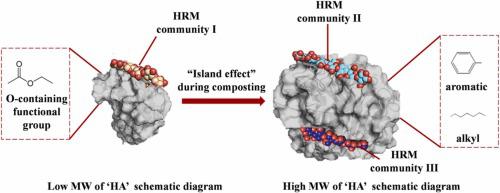Journal of Hazardous Materials ( IF 13.6 ) Pub Date : 2022-09-23 , DOI: 10.1016/j.jhazmat.2022.130049 Xinyu Zhao 1 , Qiuling Dang 1 , Chuanyan Zhang 2 , TianXue Yang 1 , Tiancheng Gong 1 , Beidou Xi 3

|
Humic acids (HAs) coupled with humic-reducing microorganisms (HRMs) can facilitate contaminants reduction. Molecular-weight (MW) of HA governs the chemical and HRMs behavior. However, MW of HAs with chemical characteristics linking to HRMs in different wastes composting have never been investigated. Results from the HPSEC-UV analysis showed that composting significantly increased weight-average molecular weight (Mw) of HA with a broad range from 675 Da to 27983 Da, and governing heterogeneous chemical characteristics. In proteinaceous composts, MW< 4000 Da of HAs were greatly related to alkyl and carbonyl, while MW> 20000 Da of HAs were presented by oxygen–nitrogenous functional groups, methyl, and alkyl groups. For cellulosic composts, MW< 1500 Da and 4000–10000 Da of HAs were characterized by aliphatic ethers and aromatic groups. MW> 20000 Da of HAs were constructed by phenols, methoxy and nitrogen functional groups. In lignocellulosic composts, MW> 20000 Da of HAs were only characterized by aromatic groups. Furthermore, seven groups of HRMs adapted to the heterogeneous chemical characteristics within HAs ranked by MW were recognized. Consequently, the possible routes that composting properties response to the connections of HRMs-chemical structures-MW of HAs in proteinaceous, cellulosic and lignocellulosic composts were constructed, respectively. Our results can help to develop the fine classification-oriented approach for recycling utilization of organic wastes.
中文翻译:

重新审视有机废物来源依赖的分子量控制腐殖酸中的表征,喜欢堆肥过程中的腐殖质还原微生物
腐殖酸 (HA) 与腐殖质还原微生物 (HRM) 结合可以促进污染物的减少。HA 的分子量 (MW) 控制着化学和 HRM 行为。然而,在不同的废物堆肥中,具有与 HRM 相关的化学特性的 HA 的 MW 从未被研究过。HPSEC-UV 分析的结果表明,堆肥显着增加了重均分子量 (M w) 的 HA 具有从 675 Da 到 27983 Da 的宽范围,并控制异质化学特征。在蛋白质堆肥中,MW<4000 Da 的 HAs 与烷基和羰基有很大关系,而 MW>20000 Da 的 HAs 则由氧-氮官能团、甲基和烷基表示。对于纤维素堆肥,MW<1500 Da 和 4000-10000 Da 的 HA 以脂肪族醚和芳香族基团为特征。MW>20000 Da的HAs由酚、甲氧基和氮官能团构成。在木质纤维素堆肥中,MW> 20000 Da 的 HA 仅以芳香基团为特征。此外,还发现了七组 HRM,它们适应了按 MW 排序的 HA 内的异质化学特性。最后,分别构建了堆肥特性对蛋白质、纤维素和木质纤维素堆肥中 HRM-化学结构-HA MW 连接的响应的可能途径。我们的研究结果有助于开发面向精细分类的有机废物回收利用方法。



























 京公网安备 11010802027423号
京公网安备 11010802027423号